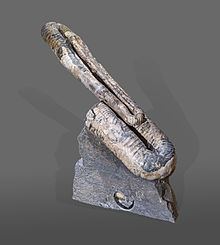Rank Genus | ||
 | ||
Similar Diplomoceratidae, Gaudryceras, Eubostrychoceras, Nipponites, Bostrychoceras | ||
Polyptychoceras is an extinct genus of ammonites from the Late Cretaceous of Asia, Europe, and North and South America. It was first named by Hisakatsu Yabe in 1927.
Contents
Species and Subspecies
This genus contains the following eight species and one subgenus, Subtychoceras, which contains one subspecies.
Description
Polyptychoceras is a heteromorph ammonite, meaning that its shell does not curl up into the tight spiral shape which shells of ammonites from the subclass Ammonoidea typically do.
Polyptychoceras shells have an abrupt weight increase after formation of the initial shaft, which represents the shell's automatic balance condition. This would have caused the shell to topple over if on land. The soft body of the animal would have to have been large, in order to keep the falling shaft off of the ground. The body would not have been resistant to the pressing shell.
Although the shafts in the fossils of the shells are usually parallel to each other, small aberrations during each growth stage often caused abrupt constrictions in the shape of the shell.
Life
A Japanese study in 1979 suggested that Polyptychoceras lived and travelled in schools, similarly to modern cuttlefish. Individual fossil specimens of a particular species of Polyptychoceras are frequently found in sediments laid down in the same bed of water, around the Santonian and Upper Coniacian faunal stages of the Late Cretaceous Epoch. Polyptychoceras was probably buoyant, and swam in a slow, somewhat up-and-down locomotion. It also likely preferred living in sheltered parts of deep sea levels, although how deep is uncertain. Subptychoceras yubarense was likely very long like an eel, and preferred a benthic mode of life.
